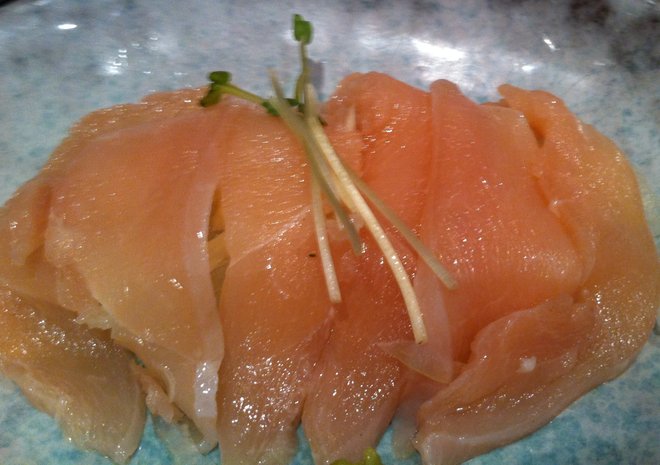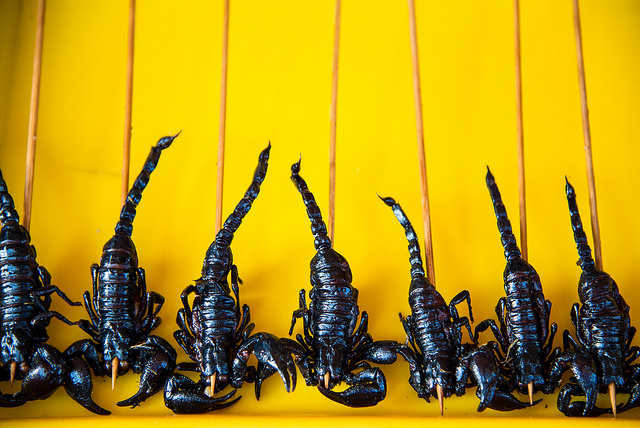
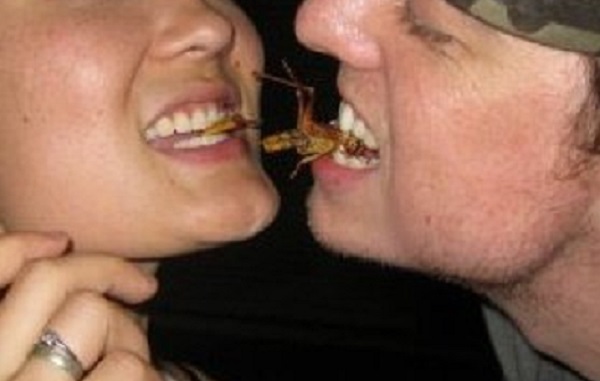
There’s a memory floating around in my head from my
volunteer time at a wildlife rehabilitation center in South Africa. It involves being
inside a dark, shed-like room with another volunteer or two, eating termites.
We
were on aviary duty, shoving our hands nearly elbow deep into plastic bags
filled with large, frozen, winged termites. We grabbed the insects by the
fistful, cupping them in our hands like snow, applying pressure to defrost them
to feed to the birds. The delicate wings, and probably some legs, broke off and
stuck to my fingers and palms; I was wearing defrosted termite gloves. And then,
the volunteer named Erin told me to eat one of the frozen bugs. I thought she
was joking until she popped one in her mouth, smiling. She said it tasted like peanut
butter. She was right.
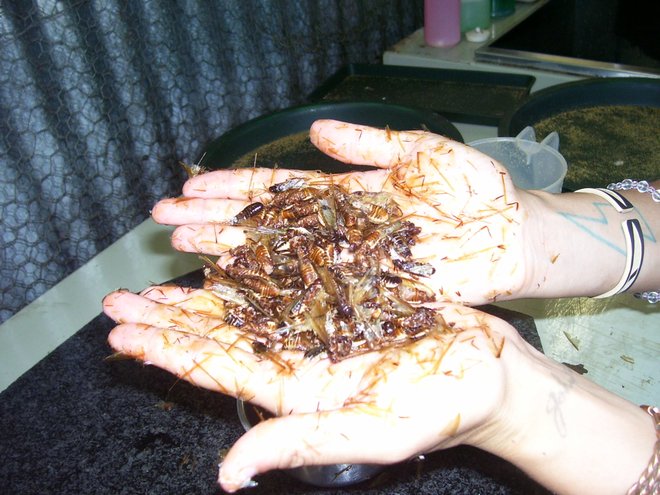
Later, outside, as we threw our fully defrosted termites
into the air to feed swooping birds, she dared me to eat another one. “It
tastes like butter,” she said, as she tossed a couple in her mouth. She was
right. Who knew that the peanut flavor would dissipate once they hit room temperature? Or perhaps the better question — who would try them to find out?
I had expected the termites to taste acidic, or like the dry,
crispy end of a French fry. Instead, these little insects melted in my mouth
with a delicate flavor that was actually kind of pleasant, like something you
might spread and serve on toast. I spent some of my remaining time kind of
hoping I’d get back on aviary duty so I could sneak a few termites without it
being weird. (Or maybe it still is.)
Looking back, this termite dare just might be responsible
for the many different culinary experiences I’ve had while traveling — leading to some of the best souvenirs, stories, and meals under my belt.
Bring on the Bugs, Thailand
Fried Crickets, Photo by Alpha via Flickr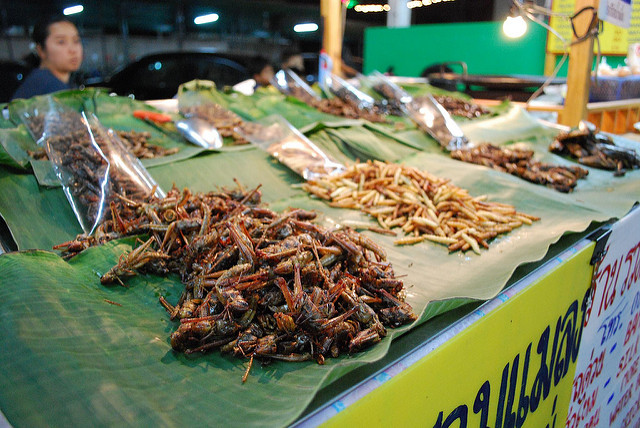
I wouldn’t say I’m a bug lover, but I may have a penchant
for ants and ant-like animals. That may be why I enthusiastically flagged down a man peddling buckets of
bugs on a busy Thai street, and gleefully purchased a lemongrass and soy sauce
ant medley (bright, light, and delicious). Without Erin (still in South Africa) to dare me, I
dared myself to try the cart’s wok-fried crickets, a.k.a. Jing Leed, which turned out crunchy, salty — and pretty boring. I was not yet brave enough to go
into giant water bug (Maeng Da) or black
scorpion territory. An unremembered amount of time later, though. I had no choice.
Water Bugs, Photo by Alpha via Flickr
Here’s the story: I’m on a rooftop, drinking a beerlao. I observe a guy sit down next to us with a plate full of
bug special: scorpion, water bug, grasshopper, grubs, crickets, — and a
tarantula. He’s going to film himself eating the plate and send the video back
home to his friends in Australia. I offer to film for him. He makes it around
the entire plate, struggling with the water bug — a meal you’re supposed to
take apart, ripping off it’s head and wings, eating only the insides. He’d
shoved the whole thing into his mouth before I realize I’ve not actually hit
record. I offer to buy him a new round of bugs for a take two, but he insists,
the next round is on him and as my punishment, I’ll be co-starring.
Black Scorpion, Photo by Kenneth Moore via Flickr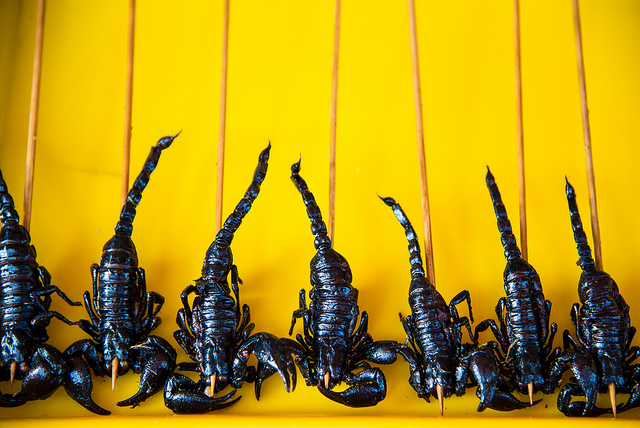
I refuse to eat the water bug, but have no problem crunching
my way through the cricket, grasshopper, and grubs. I nearly break my jaw on
the impossibly hard, two-millimeter-thick exoskeleton of the scorpion. I use my
canines to break through the bulbous pinchers; I’m not sure this is meant to be
edible. It tastes like absolutely nothing and I chew fast to get through the
thorax, shoving the legs back into my mouth as they pop out. Some people say it
tastes like popcorn or shellfish. I think it tastes like a big mistake.
Donkey Burgers and Ragu in China and Italy
Donkey Burger in Beijing, Photo by Garrett Ziegler via Flickr
Speaking of mistakes (and another culinary adventure), I felt immediate regret after waking
up in China one morning only to find out that the absolutely delicious pita-looking
sandwich I’d literally stumbled upon the night before was actually one of
China’s popular donkey burgers. However delicious, this information was hard to
swallow, so I vowed right then and there to never, ever eat the
lamb-meets-beef-like meat of a donkey again, no matter how sweet, spicy, and
seriously stupendous it was. But honestly, between you and me — and everyone who
has ever eaten donkey — it is so delicious that I made sure to eat it one more
time before I left China – and then again when the opportunity arose in Italy.
Yes, in fact, donkey is not one of those “bizarre” meats
only eaten in the East; it’s a common find in places like France, Iceland, and Italy. Verona,
specifically, is known for its exceptionally tasty Ragu d’asino, or Donkey Ragu. And you know what? Turns out donkey
is just as delicious in a gourmet Western ragu as it is stuffed inside a greasy
pita on the streets of Beijing. But make no mistake; as divine as my taste buds
thought it was to be noshing on donkey again, my mind couldn’t get over the
fact — thereby constantly activating my gag reflex.
Italy's Horse Steak
Once you’ve eaten donkey, being asked by your Italian host
family, “Would you be okay to eat horse for dinner?” doesn’t seem like much of
a stretch. So, in a small village just a few miles from Tirano, I had a thick, nonchalant
horse steak cooked medium well, and served outside on a warm summer evening. Like
donkey, it was a little hard to reconcile what I was eating in my head. It tastes somewhere between beef and a large antelope (read: slightly gamier, though
still a somewhat delicate red meat). If if you really want to enjoy the nuance of
horse, you should, firstly, not at all have an affinity for the animal, and
secondly, head to Japan (where I still regret not giving the raw sashimi-style
horse meat a go). I imagine it tastes a bit like ostrich carpaccio, which, unlike the large bird’s large gamey eggs, I
absolutely love.
Even Chicken Can Be "Sushi" in Japan
As I mentioned, I reluctantly passed on the raw horse meat in
Japan, but I am proud to say that I didn’t pass up trying the raw sliced
chicken. While I would never try raw chicken off a menu in the United States (if that even existed), I
trusted the quality and appreciated the uniqueness of this menu item at my
local izakaya in Japan. The dish
arrived much like sushi, though instead of colorful sliced fish, I was about to
tuck into the raw, light beige-pink flesh of a chicken. I’m not going to play
it cool; I was nervous. I didn’t want to spend the next few days vomiting from
salmonella, but in the end, I felt the reward out-weighed the risk and I tucked
in.
If, like me, you’ve imagined raw chicken tasting a bit like
the way it feels – slimy with little flavor or appeal – you’d be wrong. Hands
down this was one of the best food gambles I’ve ever made. I found raw chicken
to be the ultimate sushi, meaty yet delicate, subtle yet full of flavor. I
highly recommend the experience.
Fugu, a.k.a. Blowfish, Japan
Blowfish, Photo by tsuda via Flickr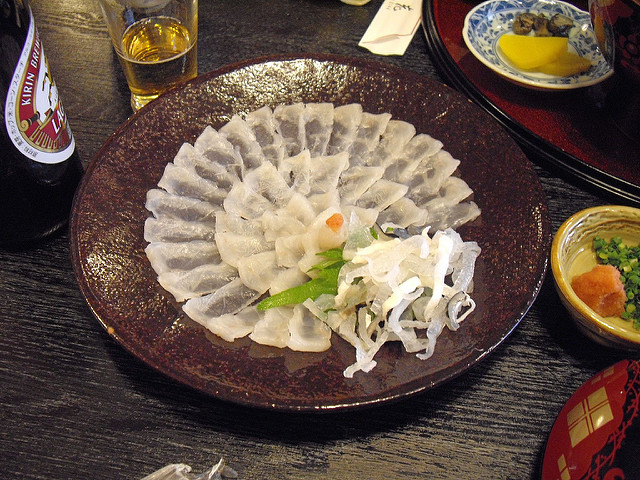
Possibly Japan’s most notorious adventurous eat, fugu was on my must-try list from the
second I knew I was heading to the country. However, I didn’t want to taunt death
alone, so I enlisted a friend from my hostel in Osaka. If you aren’t familiar
with the risk of blowfish, it’s simple: if the fish meat is sliced the wrong
way, it releases a paralyzing toxin into the flesh, where the best-case scenario
is a numb mouth, and the worst — death. Naturally, we spoke to the front desk and
had them write “Could you please leave a little bit of poison in to make our
lips numb?” on a note for us in Japanese. The sushi chef refused, stating that it
was against the law.
With the majority of the thrill gone, we reluctantly ate our
raw, thin-sliced blowfish, which tasted a lot like absolutely nothing — still
hoping to feel a little something numbing our lips.
Brains, Hearts, and All the Other "Other" Parts Right Here in the U.S.
The first time I ever had tripe, or intestine, I was a child
eating a can of Campbell’s pepper pot soup at my grandparents’ dining room
table. I thought it was the best soup I’d ever had. And I looked for it
relentlessly whenever we got back home to Florida. This soup taught me three
lessons: one, I learned that not all products are sold in all markets; two, I
learned that eating “other” animal parts wasn’t restrictive to “other” parts of
the world; and three, I learned that I could actually really love something
that other people thought was disgusting. Like the termites in South Africa, it’s
now obvious that opening this can of soup actually opened up a whole new world
for me, making me more confident and adventurous in my food choices.
It’s no wonder that I’ve gone on to enjoy eating hearts
(delicious), liver (it’s basically pate, folks), raw oysters (yes, please),
tendon (nomnomnom), and chicken feet (oh wait, I wasn’t a fan of this so much).
More surprising to me is that I’ve found most of these “other” animal parts on
menus right here in America. It’s very convenient. In fact, a small breakfast diner in my hometown serves up super soft pork brain and egg scrambles (it’s a bit too soft for me), and menus along the beaches are known to sport fried alligator bites (a little too tough for me — tastes like a cross between fish and chicken).
The Most Controversial: Dog in China
Variety of Raw Meats for a Hot Pot, Photo by llee_wu via Flickr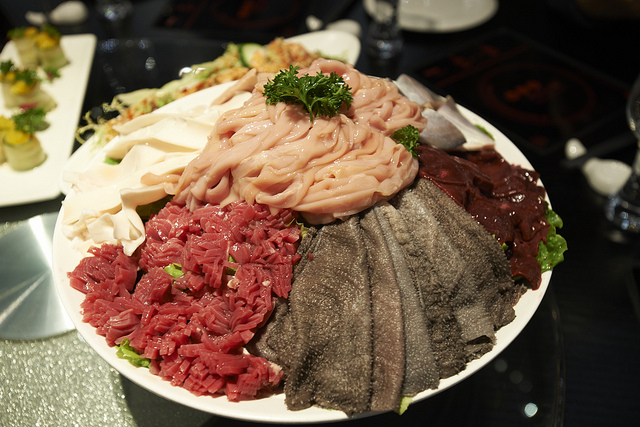
Okay, I’ve saved, not the best, but certainly the most risque or controversial dish for last. There’s
no easy way to go into this, so I’m just going to say it: I’ve eaten dog. Yes,
it was in Asia. No, I didn’t like it at all. And no, let me be clear — I had no idea at the time
that it was dog. So,
what does dog taste like? Well, first let me explain that it’s not just any
dog. In China, there is a specific breed of dog used for cooking. While I was
in the ultra-spicy Sichuan province of China, my hostel hosts took me and
another boarder to numb our faces off at a local hot pot restaurant. They
ordered everything. The broth was dark red, everyone was throwing everything in
the boiling pot. In the free-for-all, I pulled out vegetables, I pulled out
noodles, I pulled out meat.
Even though I couldn’t feel the bottom half of my face, I
had already decided this was one of the best meals I’d ever had in my life. I couldn’t get enough. We
dumped more and more food into the broth, and it all was spicy heaven. Until I
tried the meat; it was greasy, tasted a bit dirty, and maybe spoiled.
“What is this?” I asked. They replied, “Meat.” I tried
another piece. Something was still off. I asked again. They gave me the same
reply, this time with a slight laugh. So, I turned to my hostel-mate, and she
quietly said, “I think it’s dog. They brought me here last week and ordered
dog.” I snapped my head back toward the men from the hostel. “Was that dog? Was that meat dog meat?” I asked half-frantically. The two men from the hostel nodded.
“Well, whatever it was,” I said, “it was disgusting.”
Editor’s Note: Some of the aforementioned delicacies are considered controversial, and the mention of them in this story does not imply Oyster.com’s consent of their consumption.
Related Stories:
- Famous Quotes On Why You Should Travel Solo At Least Once
- The Most Bizarre Travel Stories From 2015
- 13 Traditional Christmas Dinners From Around the World
All products are independently selected by our writers and editors. If you buy something through our links, Oyster may earn an affiliate commission.
